BMW 640I CONVERTIBLE 2015 Owners Manual
Manufacturer: BMW, Model Year: 2015, Model line: 640I CONVERTIBLE, Model: BMW 640I CONVERTIBLE 2015Pages: 259, PDF Size: 7.85 MB
Page 181 of 259
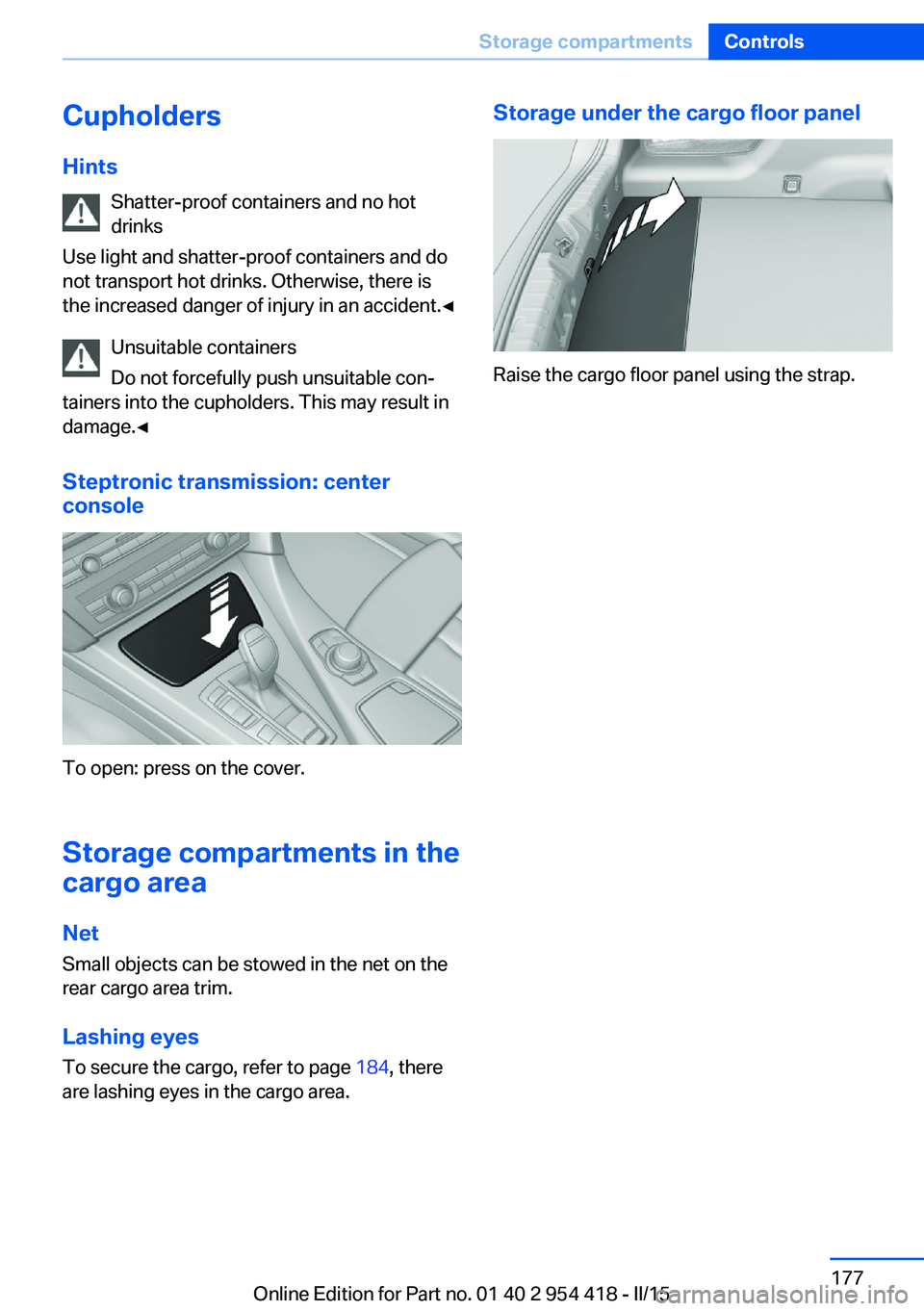
Cupholders
Hints Shatter-proof containers and no hot
drinks
Use light and shatter-proof containers and do
not transport hot drinks. Otherwise, there is the increased danger of injury in an accident.â
Unsuitable containers
Do not forcefully push unsuitable conâ
tainers into the cupholders. This may result in
damage.â
Steptronic transmission: center
console
To open: press on the cover.
Storage compartments in the
cargo area
Net Small objects can be stowed in the net on the
rear cargo area trim.
Lashing eyes To secure the cargo, refer to page 184, there
are lashing eyes in the cargo area.
Storage under the cargo floor panel
Raise the cargo floor panel using the strap.
Seite 177Storage compartmentsControls177
Online Edition for Part no. 01 40 2 954 418 - II/15
Page 182 of 259
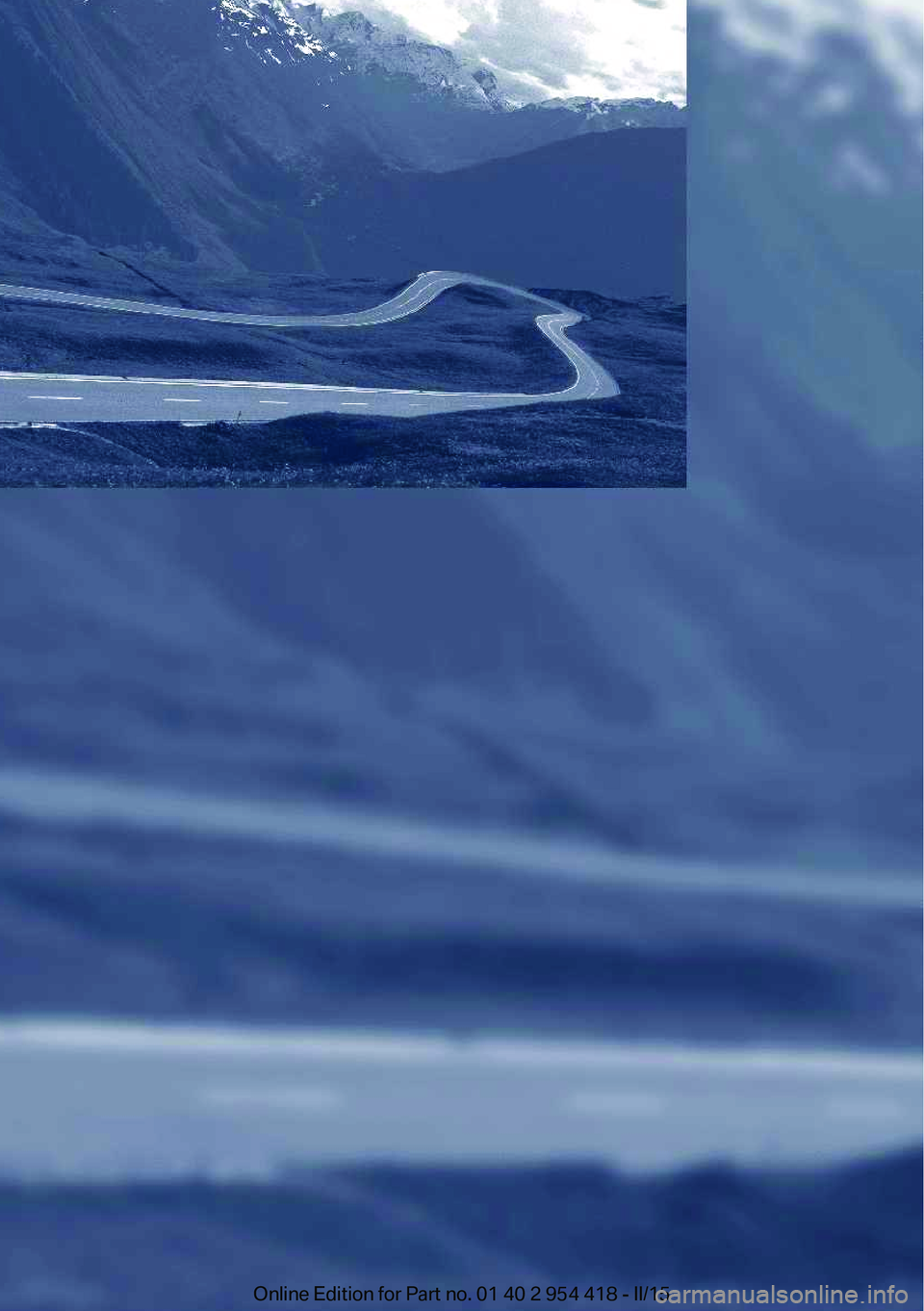
Online Edition for Part no. 01 40 2 954 418 - II/15
Page 183 of 259
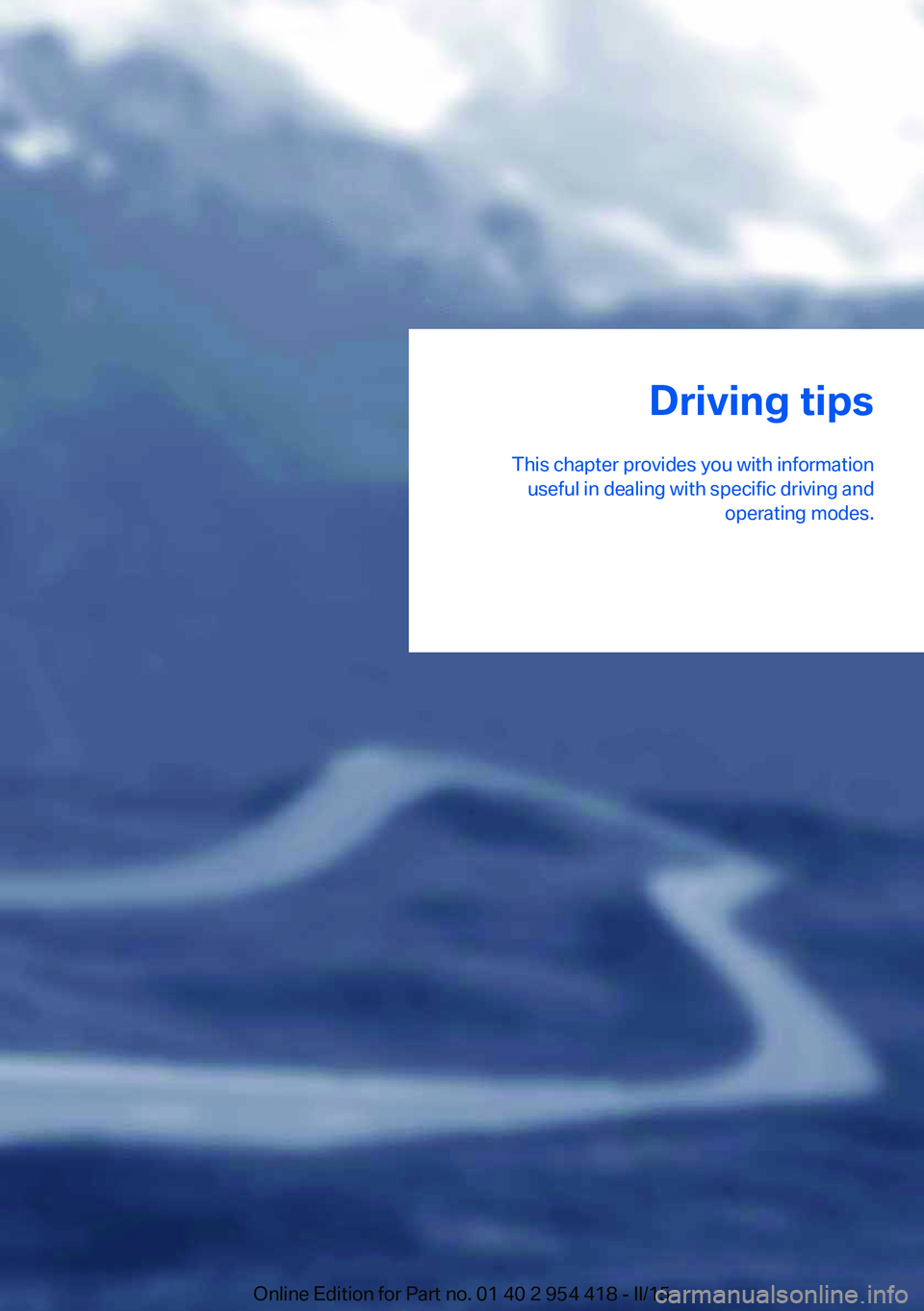
Driving tips
This chapter provides you with information useful in dealing with specific driving and operating modes.Online Edition for Part no. 01 40 2 954 418 - II/15
Page 184 of 259

Things to remember when drivingVehicle features and options
This chapter describes all standard, country-
specific and optional features offered with the
series. It also describes features that are not
necessarily available in your car, e. g., due to
the selected options or country versions. This
also applies to safety-related functions and
systems. The respectively applicable country
provisions must be observed when using the
respective features and systems.
Breaking-in period General information
Moving parts need time to adjust to one anâ
other (break-in time).
The following instructions will help accomplish
a long vehicle life and good efficiency.
During break-in, do not use the Launch Conâ
trol, refer to page 81.
Engine, transmission, and axle drive
Up to 1,200 miles/2,000 km
Do not exceed the maximum engine and road
speed:âˇFor gasoline engine 4,500 rpm and
100 mph/160 km/h.
Avoid full load or kickdown under all circumâ
stances.
From 1,200 miles/2,000 km The engine and vehicle speed can gradually be
increased.
Tires
Tire traction is not optimal due to manufacturâ
ing circumstances when tires are brand-new;
they achieve their full traction potential after a
break-in time.
Drive conservatively for the first
200 miles/300 km.
Brake system
Brakes require an initial break-in period of apâ
prox. 300 miles/500 km to achieve optimal perâ
formance between brake discs and brake
pads. Drive moderately during this break-in peâ
riod.
Following part replacement
The same break-in procedures should be obâ
served if any of the components above-menâ
tioned have to be renewed in the course of the
vehicle's operating life.
General driving notes
Closing the trunk lid Drive with the trunk lid closed
Only drive with the tailgate closed; otherâ
wise, in the event of an accident or braking and
evasive maneuvers, passengers and other trafâ
fic may be injured, and the vehicle may be
damaged. In addition, exhaust fumes may enâ
ter the vehicle interior.â
If driving with the tailgate open cannot be
avoided:âˇIf the convertible top is closed, close all
windows.âˇGreatly increase the air flow from the vents.âˇDrive moderately.Seite 180Driving tipsThings to remember when driving180
Online Edition for Part no. 01 40 2 954 418 - II/15
Page 185 of 259
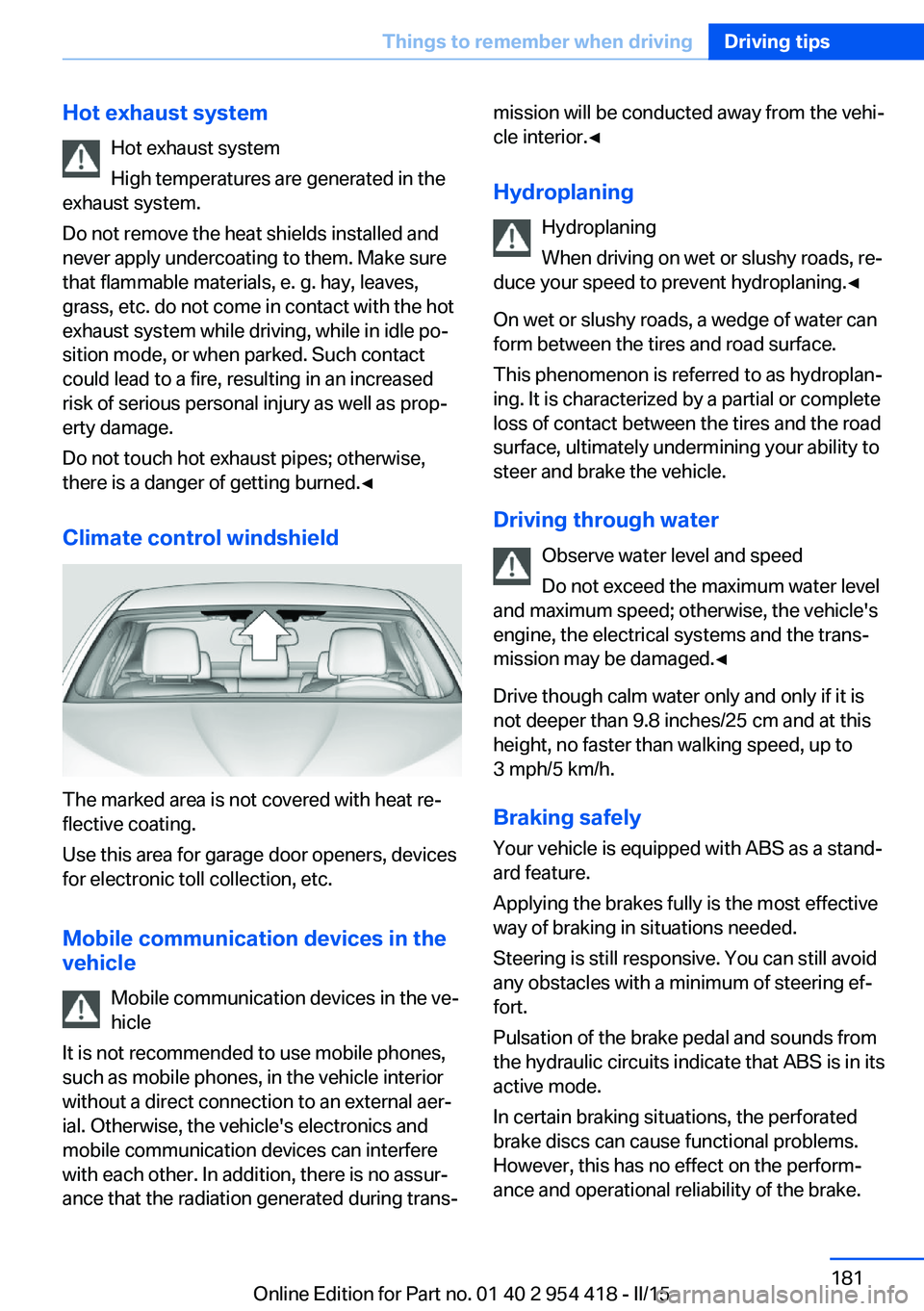
Hot exhaust systemHot exhaust system
High temperatures are generated in the
exhaust system.
Do not remove the heat shields installed and
never apply undercoating to them. Make sure
that flammable materials, e. g. hay, leaves,
grass, etc. do not come in contact with the hot
exhaust system while driving, while in idle poâ
sition mode, or when parked. Such contact
could lead to a fire, resulting in an increased
risk of serious personal injury as well as propâ
erty damage.
Do not touch hot exhaust pipes; otherwise,
there is a danger of getting burned.â
Climate control windshield
The marked area is not covered with heat reâ
flective coating.
Use this area for garage door openers, devices
for electronic toll collection, etc.
Mobile communication devices in the vehicle
Mobile communication devices in the veâ
hicle
It is not recommended to use mobile phones,
such as mobile phones, in the vehicle interior
without a direct connection to an external aerâ
ial. Otherwise, the vehicle's electronics and
mobile communication devices can interfere
with each other. In addition, there is no assurâ
ance that the radiation generated during transâ
mission will be conducted away from the vehiâ
cle interior.â
Hydroplaning Hydroplaning
When driving on wet or slushy roads, reâ
duce your speed to prevent hydroplaning.â
On wet or slushy roads, a wedge of water can
form between the tires and road surface.
This phenomenon is referred to as hydroplanâ
ing. It is characterized by a partial or complete
loss of contact between the tires and the road
surface, ultimately undermining your ability to
steer and brake the vehicle.
Driving through water Observe water level and speed
Do not exceed the maximum water level
and maximum speed; otherwise, the vehicle's
engine, the electrical systems and the transâ
mission may be damaged.â
Drive though calm water only and only if it is
not deeper than 9.8 inches/25 cm and at this
height, no faster than walking speed, up to
3 mph/5 km/h.
Braking safely
Your vehicle is equipped with ABS as a standâ
ard feature.
Applying the brakes fully is the most effective
way of braking in situations needed.
Steering is still responsive. You can still avoid
any obstacles with a minimum of steering efâ
fort.
Pulsation of the brake pedal and sounds from
the hydraulic circuits indicate that ABS is in its
active mode.
In certain braking situations, the perforated
brake discs can cause functional problems.
However, this has no effect on the performâ
ance and operational reliability of the brake.Seite 181Things to remember when drivingDriving tips181
Online Edition for Part no. 01 40 2 954 418 - II/15
Page 186 of 259
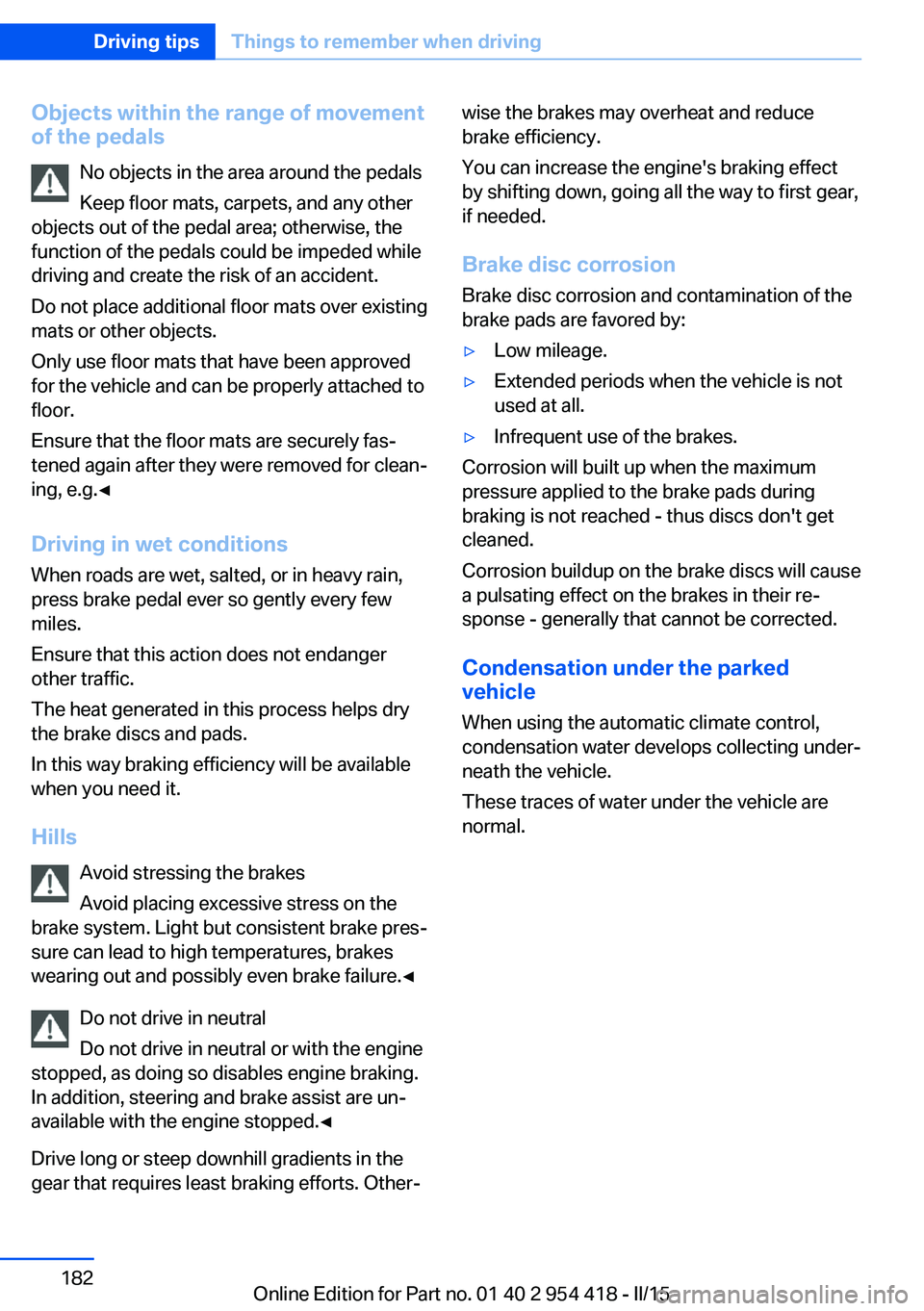
Objects within the range of movement
of the pedals
No objects in the area around the pedals
Keep floor mats, carpets, and any other
objects out of the pedal area; otherwise, the
function of the pedals could be impeded while
driving and create the risk of an accident.
Do not place additional floor mats over existing
mats or other objects.
Only use floor mats that have been approved
for the vehicle and can be properly attached to
floor.
Ensure that the floor mats are securely fasâ
tened again after they were removed for cleanâ
ing, e.g.â
Driving in wet conditions When roads are wet, salted, or in heavy rain,
press brake pedal ever so gently every few
miles.
Ensure that this action does not endanger other traffic.
The heat generated in this process helps dry
the brake discs and pads.
In this way braking efficiency will be available
when you need it.
Hills Avoid stressing the brakes
Avoid placing excessive stress on the
brake system. Light but consistent brake presâ
sure can lead to high temperatures, brakes
wearing out and possibly even brake failure.â
Do not drive in neutral
Do not drive in neutral or with the engine
stopped, as doing so disables engine braking.
In addition, steering and brake assist are unâ
available with the engine stopped.â
Drive long or steep downhill gradients in the
gear that requires least braking efforts. Otherâwise the brakes may overheat and reduce
brake efficiency.
You can increase the engine's braking effect
by shifting down, going all the way to first gear,
if needed.
Brake disc corrosion
Brake disc corrosion and contamination of the
brake pads are favored by:âˇLow mileage.âˇExtended periods when the vehicle is not
used at all.âˇInfrequent use of the brakes.
Corrosion will built up when the maximum
pressure applied to the brake pads during
braking is not reached - thus discs don't get
cleaned.
Corrosion buildup on the brake discs will cause
a pulsating effect on the brakes in their reâ
sponse - generally that cannot be corrected.
Condensation under the parked
vehicle
When using the automatic climate control,
condensation water develops collecting underâ
neath the vehicle.
These traces of water under the vehicle are
normal.
Seite 182Driving tipsThings to remember when driving182
Online Edition for Part no. 01 40 2 954 418 - II/15
Page 187 of 259
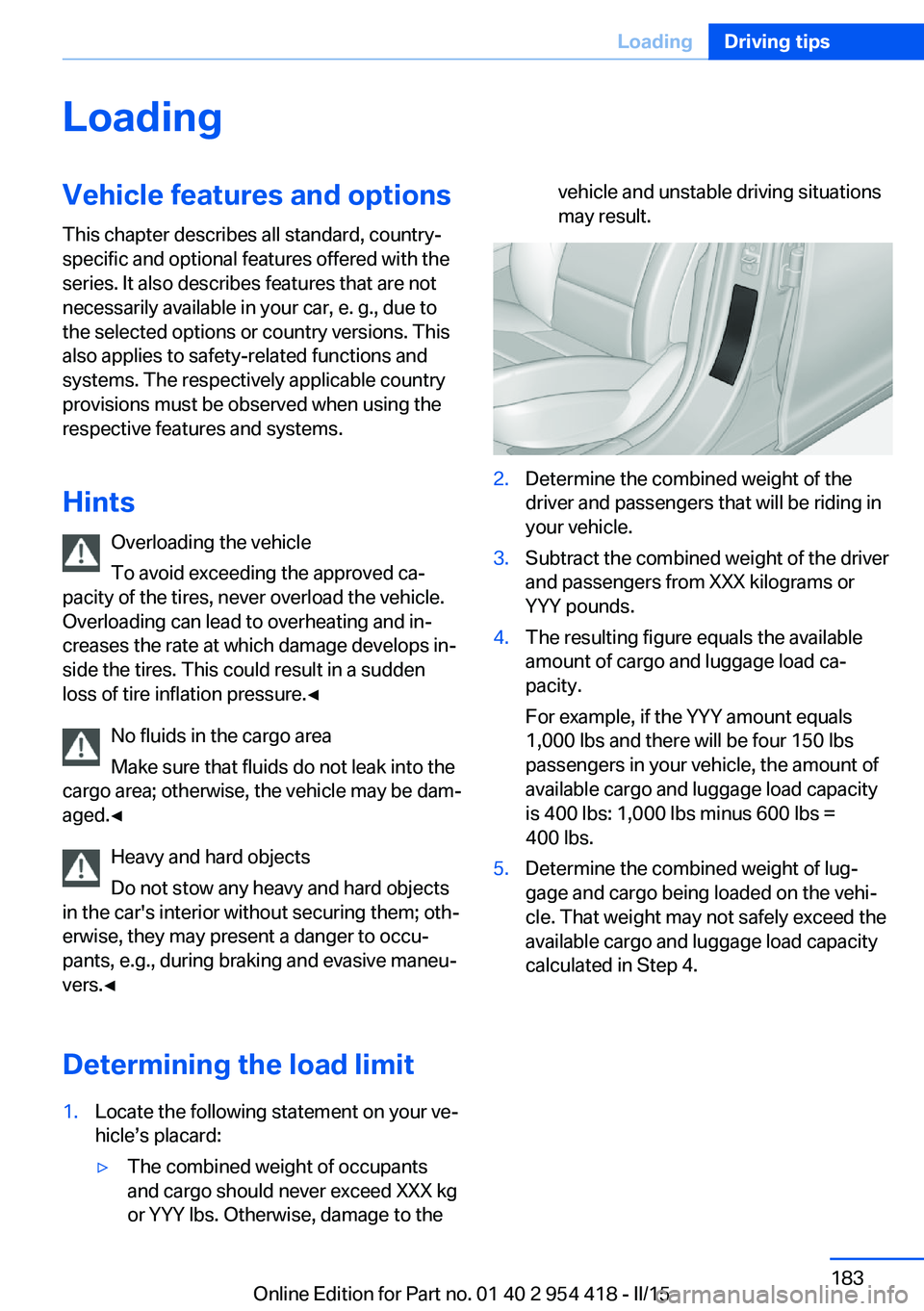
LoadingVehicle features and options
This chapter describes all standard, country-
specific and optional features offered with the
series. It also describes features that are not
necessarily available in your car, e. g., due to
the selected options or country versions. This
also applies to safety-related functions and
systems. The respectively applicable country
provisions must be observed when using the
respective features and systems.
Hints Overloading the vehicle
To avoid exceeding the approved caâ
pacity of the tires, never overload the vehicle.
Overloading can lead to overheating and inâ
creases the rate at which damage develops inâ
side the tires. This could result in a sudden
loss of tire inflation pressure.â
No fluids in the cargo area
Make sure that fluids do not leak into the
cargo area; otherwise, the vehicle may be damâ
aged.â
Heavy and hard objects
Do not stow any heavy and hard objects
in the car's interior without securing them; othâ
erwise, they may present a danger to occuâ
pants, e.g., during braking and evasive maneuâ
vers.â
Determining the load limit1.Locate the following statement on your veâ
hicleâs placard:âˇThe combined weight of occupants
and cargo should never exceed XXX kg
or YYY lbs. Otherwise, damage to thevehicle and unstable driving situations
may result.2.Determine the combined weight of the
driver and passengers that will be riding in
your vehicle.3.Subtract the combined weight of the driver
and passengers from XXX kilograms or
YYY pounds.4.The resulting figure equals the available
amount of cargo and luggage load caâ
pacity.
For example, if the YYY amount equals
1,000 lbs and there will be four 150 lbs
passengers in your vehicle, the amount of
available cargo and luggage load capacity
is 400 lbs: 1,000 lbs minus 600 lbs =
400 lbs.5.Determine the combined weight of lugâ
gage and cargo being loaded on the vehiâ
cle. That weight may not safely exceed the
available cargo and luggage load capacity
calculated in Step 4.Seite 183LoadingDriving tips183
Online Edition for Part no. 01 40 2 954 418 - II/15
Page 188 of 259
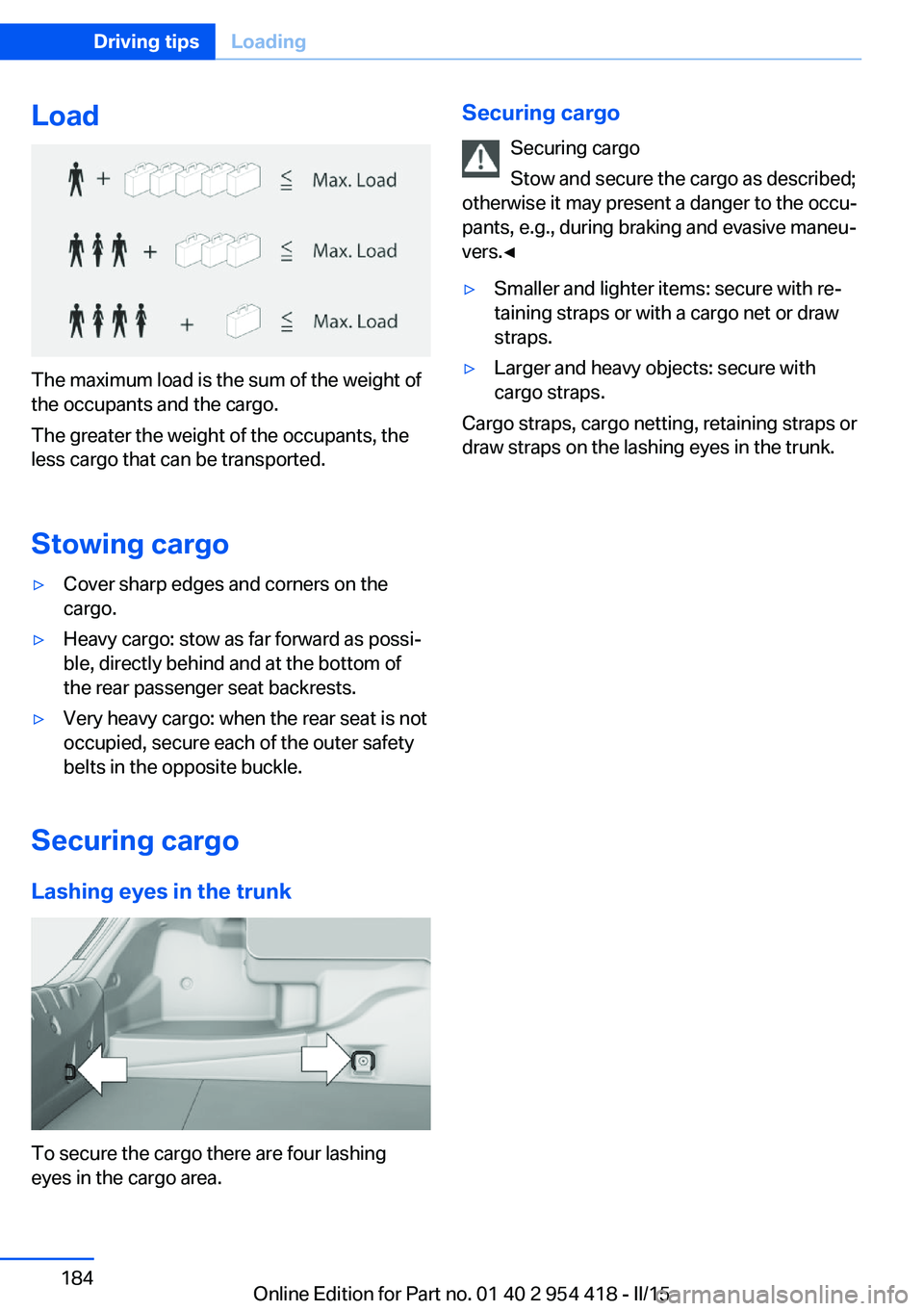
Load
The maximum load is the sum of the weight of
the occupants and the cargo.
The greater the weight of the occupants, the
less cargo that can be transported.
Stowing cargo
âˇCover sharp edges and corners on the
cargo.âˇHeavy cargo: stow as far forward as possiâ
ble, directly behind and at the bottom of
the rear passenger seat backrests.âˇVery heavy cargo: when the rear seat is not
occupied, secure each of the outer safety
belts in the opposite buckle.
Securing cargo
Lashing eyes in the trunk
To secure the cargo there are four lashing
eyes in the cargo area.
Securing cargo
Securing cargo
Stow and secure the cargo as described;
otherwise it may present a danger to the occuâ
pants, e.g., during braking and evasive maneuâ
vers.ââˇSmaller and lighter items: secure with reâ
taining straps or with a cargo net or draw
straps.âˇLarger and heavy objects: secure with
cargo straps.
Cargo straps, cargo netting, retaining straps or
draw straps on the lashing eyes in the trunk.
Seite 184Driving tipsLoading184
Online Edition for Part no. 01 40 2 954 418 - II/15
Page 189 of 259
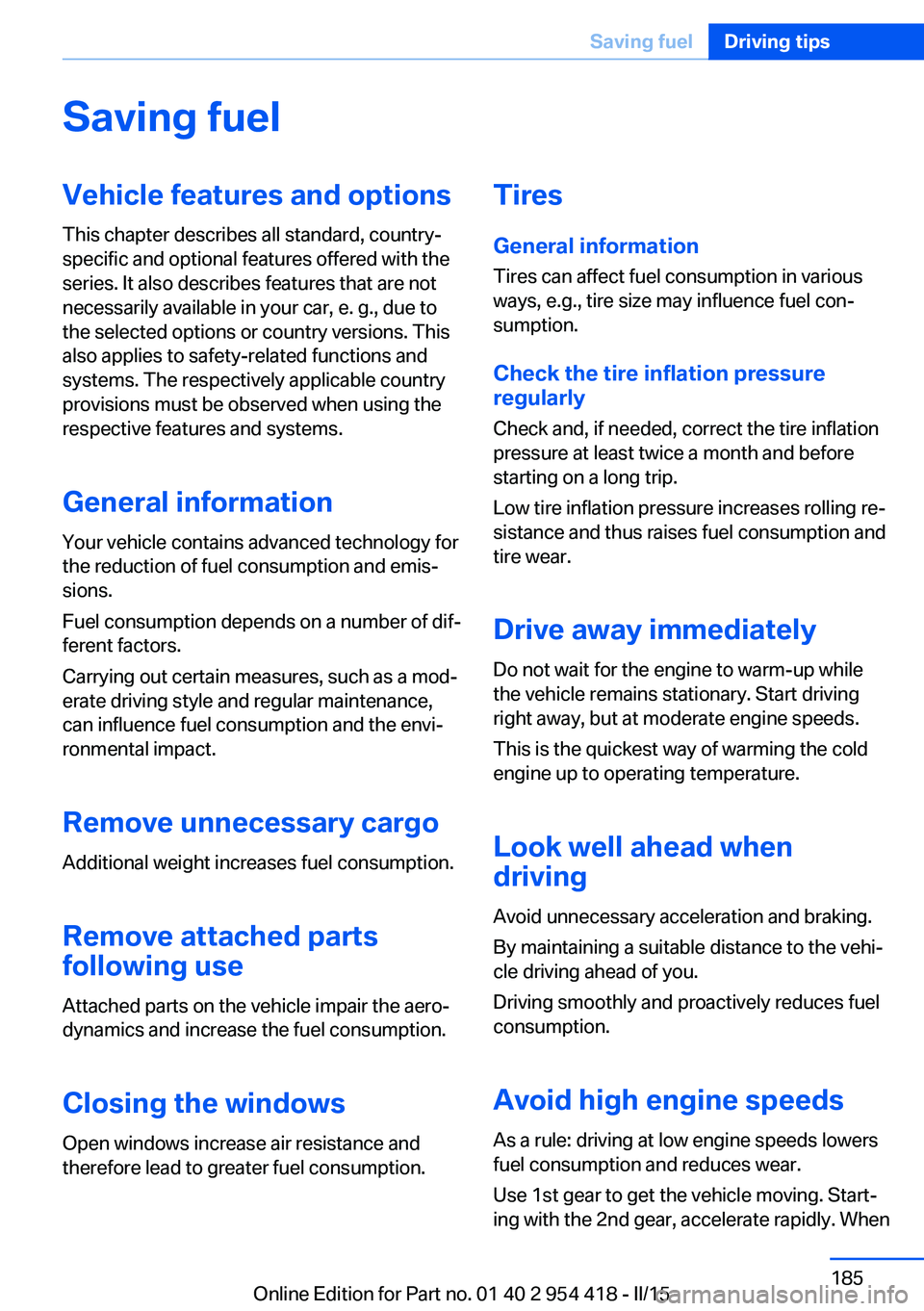
Saving fuelVehicle features and optionsThis chapter describes all standard, country-
specific and optional features offered with the
series. It also describes features that are not
necessarily available in your car, e. g., due to
the selected options or country versions. This
also applies to safety-related functions and
systems. The respectively applicable country
provisions must be observed when using the
respective features and systems.
General information Your vehicle contains advanced technology for
the reduction of fuel consumption and emisâ
sions.
Fuel consumption depends on a number of difâ
ferent factors.
Carrying out certain measures, such as a modâ
erate driving style and regular maintenance,
can influence fuel consumption and the enviâ
ronmental impact.
Remove unnecessary cargo
Additional weight increases fuel consumption.
Remove attached parts
following use
Attached parts on the vehicle impair the aeroâ
dynamics and increase the fuel consumption.
Closing the windows Open windows increase air resistance and
therefore lead to greater fuel consumption.Tires
General information
Tires can affect fuel consumption in various
ways, e.g., tire size may influence fuel conâ
sumption.
Check the tire inflation pressure
regularly
Check and, if needed, correct the tire inflation
pressure at least twice a month and before
starting on a long trip.
Low tire inflation pressure increases rolling reâ
sistance and thus raises fuel consumption and
tire wear.
Drive away immediately
Do not wait for the engine to warm-up while
the vehicle remains stationary. Start driving
right away, but at moderate engine speeds.
This is the quickest way of warming the cold
engine up to operating temperature.
Look well ahead when
driving
Avoid unnecessary acceleration and braking.
By maintaining a suitable distance to the vehiâ
cle driving ahead of you.
Driving smoothly and proactively reduces fuel
consumption.
Avoid high engine speeds
As a rule: driving at low engine speeds lowers
fuel consumption and reduces wear.
Use 1st gear to get the vehicle moving. Startâ
ing with the 2nd gear, accelerate rapidly. WhenSeite 185Saving fuelDriving tips185
Online Edition for Part no. 01 40 2 954 418 - II/15
Page 190 of 259
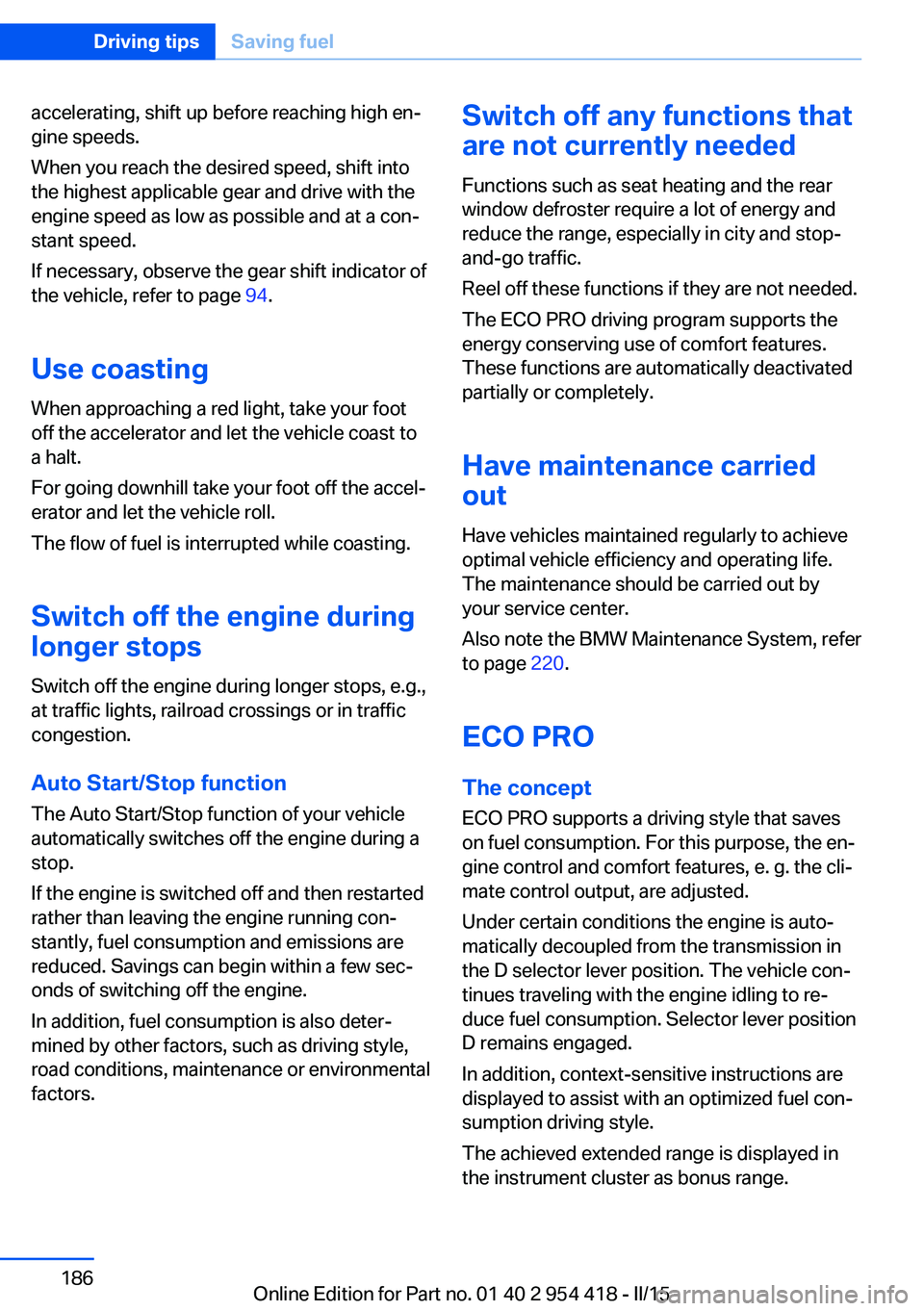
accelerating, shift up before reaching high enâ
gine speeds.
When you reach the desired speed, shift into
the highest applicable gear and drive with the
engine speed as low as possible and at a conâ
stant speed.
If necessary, observe the gear shift indicator of
the vehicle, refer to page 94.
Use coasting When approaching a red light, take your foot
off the accelerator and let the vehicle coast to
a halt.
For going downhill take your foot off the accelâ
erator and let the vehicle roll.
The flow of fuel is interrupted while coasting.
Switch off the engine during
longer stops
Switch off the engine during longer stops, e.g.,
at traffic lights, railroad crossings or in traffic
congestion.
Auto Start/Stop function The Auto Start/Stop function of your vehicle
automatically switches off the engine during a
stop.
If the engine is switched off and then restarted
rather than leaving the engine running conâ
stantly, fuel consumption and emissions are
reduced. Savings can begin within a few secâ
onds of switching off the engine.
In addition, fuel consumption is also deterâ
mined by other factors, such as driving style,
road conditions, maintenance or environmental
factors.Switch off any functions that
are not currently needed
Functions such as seat heating and the rear
window defroster require a lot of energy and
reduce the range, especially in city and stop-
and-go traffic.
Reel off these functions if they are not needed.
The ECO PRO driving program supports the
energy conserving use of comfort features.
These functions are automatically deactivated
partially or completely.
Have maintenance carried
out
Have vehicles maintained regularly to achieve
optimal vehicle efficiency and operating life.
The maintenance should be carried out by
your service center.
Also note the BMW Maintenance System, refer
to page 220.
ECO PRO
The concept
ECO PRO supports a driving style that saves
on fuel consumption. For this purpose, the enâ
gine control and comfort features, e. g. the cliâ
mate control output, are adjusted.
Under certain conditions the engine is autoâ
matically decoupled from the transmission in
the D selector lever position. The vehicle conâ
tinues traveling with the engine idling to reâ
duce fuel consumption. Selector lever position
D remains engaged.
In addition, context-sensitive instructions are
displayed to assist with an optimized fuel conâ
sumption driving style.
The achieved extended range is displayed in
the instrument cluster as bonus range.Seite 186Driving tipsSaving fuel186
Online Edition for Part no. 01 40 2 954 418 - II/15